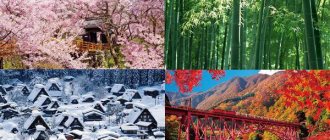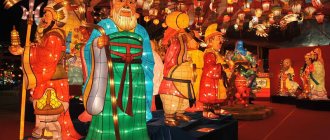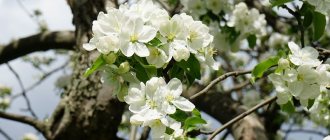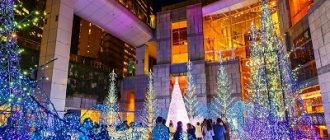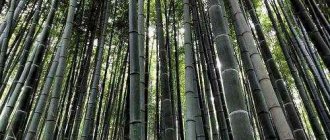Majestic charm
Japan stretches far from north to south, and there are perhaps not many countries in the world where a variety of trees can grow to gigantic sizes.
The Shirakami mountain range, located in Aomori and Akita prefectures, and Yakushima Island in Kagoshima Prefecture were designated a UNESCO World Natural Heritage Site in 1993, bringing the giant trees to public attention. The main role in this was played, of course, by Jomonsugi - “Cryptomeria Jomon” in Yakushima. And yet, despite its size and fame, its own name, reminiscent of the Jomon period (13,000-300 BC), this most famous Japanese giant tree is only in 20th place in terms of trunk thickness.
In Japan, the camphor tree (kusunoki) is especially famous for its ability to grow to gigantic sizes, and the trunk girth of the Great Camphor Tree Gamo (Gamo no okusu) is more than 24 meters. If you stand at the trunk and look up at the crown, the size of this tree will take your breath away, and this is understandable, since its girth is three times that of Jomonsugi.
The concept of a “giant tree” is usually determined by the thickness of the trunk. Trees with a trunk girth of more than three meters are often called “huge trees” (kyoboku), and those with a trunk girth of more than five meters are called “giant trees.” (kyoju). Even trees that are 1,000 years old, regardless of their height, are not called “giant trees” if they have insufficient trunk girth.
In Japan, among the “giant trees”, the most common are cryptomeria (sugi), camphor tree (kusunoki), zelkova (keyaki), ginkgo (ite), but there are also castanopsis (sudajii), Japanese oak (itiigashi), Japanese scarlet ( katsura), oaks (nara), pine trees (matsu), afananta (mukunoki), a variety of edohigan cherry and others. On the West Coast of America there are forests of sequoiadendrons, which are among the largest trees in the world, but there are practically no forests where other tree species can compete with them in size. In Japan, it often happens that within the same sanctuary or Buddhist temple, giant trees of different species grow - cryptomeria and zelkova, ginkgo, etc. The warm and humid Japanese climate contributes to the fact that a variety of trees can grow to enormous sizes.
Giant trees are the largest and longest-living living creatures on Earth, their lives last one or two orders of magnitude longer than humans, so you can’t help but be in awe of them. We should not forget that a tree has to constantly live where it once took root, and even if it has lived for a thousand years, changes in the environment around it can lead to its rapid death.
Plants of Japan.
Good day, dear readers!
Each place has its own characteristics. Japan is also different from other places. For example, because various plants grow there, which you won’t find anywhere else in Russia. Today we will get acquainted with the wonders of the plant world of Japan!
Japanese zelkova.
One of the most common trees on the Japanese islands is Japanese zelkova (lat. Zelkova serrata, Japanese けやき (欅)) - a deciduous tree up to 30 m tall and with a trunk up to 2 m in diameter with a dense crown and scaly bark.
Birch trees native to Japan.
There are birches in Japan that are so beloved by Russians, about 10 species in total. Japanese white birch (Betula japonica, colloquially Japanese quince) is found mainly in Hokkaido, although it can also be seen in the mountainous regions of Honshu, in the Nagano region. The Japanese do not treat birch as reverently and romantically as the Russians; rather, they even try to avoid it. This is all thanks to the white color of the bark, since white in Japan is a symbol of death and mourning. Japanese white birch is a beautiful tree up to 30 m high. There are few pure birch groves; Japanese birch thickets are found in broad-leaved forests along with maple, linden and oak, or mixed forests where oak, fir and cedar grow. Japanese white birch is a fairly close relative of European white birch (Betula pendula), but it is more sensitive to cold.
In Hokkaido, chaga, the so-called birch mushroom, kabanoanatake, is collected from birch trees, from which medicine is prepared. A research center in Sapporo, Hokkaido, has discovered lignin in chaga, an enzyme that has the ability to suppress the AIDS virus. Chaga infusion is used as a means to strengthen the immune system, to prevent heart disease, myocardial infarction and thrombosis.
Ehrman's birch (Betula ermanii) is more common on the islands of Hokkaido, Honshu and Shikoku. It grows among coniferous or mixed mountain forests, closer to the subalpine zone in single trees or groups, in some places it forms the upper border of the forest, and is found sporadically on rocky placers and along the banks of mountain rivers. It can grow in rocky places where other tree species do not grow due to lack of soil. It is also called stone for its very dense, heavy wood, which sinks in water and serves as a substitute for red oak. Erman's birch has brown-red, peeling bark that hangs in rags, and large matte leaves, sometimes reaching 10 cm in length. The height of the trees reaches 30 meters, but in extreme conditions it can be lower, forming gnarled, creeping trunks. Lives up to 300-400 years.
Another species grows on the islands of Kyushu, Shikoku and Honshu - the hornbeam birch or Japanese cherry birch (Betula grossa), the Japanese call it Azusa. It grows in the mountains at an altitude of 1000-1500 meters above sea level in a community with Vicha fir, Ayan spruce, larch Larix kaempferi, hemlock (Tsuga diversifolia), oak (Quercus mongolica) and alder (Alnus hirsuta). This birch is also found in cryptomerium forests. This is a tree up to 25 meters high with smooth, fragrant, dark brown or almost black bark.
Enoki or ironwood.
You literally can't take a step in Japan without bumping into a Shinto shrine. Most often these are roughly hewn stone figurines of the deity Dosojin, who protects from evil spirits, the bodhisattva Jizo (Ksitigarbha, or “Womb of the Earth”), Kannon (Avalokiteshvara, sometimes called the “Goddess of Mercy”), the Shinto deity Sarutahiko and others, among a small grove.
Most often, enoki grows there - the “iron tree”, whose long branches provide good shade. Its botanical name is Chinese frame (Celtis sinensis), a tree up to 20 m high, with lanceolate-oblong or elongated oval leaves up to 15 cm long, with a very long slender apex and a sharp-serrate-crenenate edge. The upper side of the leaf is slightly hairy, matte, dark green, the lower side is lighter, with white pubescence, especially along the veins. A distinctive feature of the entire genus is the three-vein base of the leaf. The shoots are brownish, densely pubescent, but later become bare. The flowers are inconspicuous, yellowish-green. The fruits (drupes) are placed one at a time on elongated petioles located in the leaf axils, elliptical, about 1 cm thick, brown-red to black during ripening, edible. The crown of the frame is round, arched, very often widely spreading or hanging to one side. The bark of even old trees, almost like beech, is smooth and even, lead-gray or pale brown, without noticeable grooves or grids. Widely distributed throughout Japan.
In Shinto shrines you can often see an old tree tied with a rope (shimenawa is a rope made of rice straw, since ancient times it was used to fence off sacred places where Shinto rituals took place, designed to protect from evil spirits and symbolize the holiness of the place that it encloses) and fenced with a low fence - this is a sacred tree and most often it is also a frame, or as the Japanese call it, enoki. There are many legends associated with enoki and it is often depicted in paintings.
Engraving.
The place depicted in the engraving is quite real. These are the Shozoku fields located in
in the immediate vicinity of the village of Shozoku-machi, the roofs of which can be seen on the right side of the engraving. Somewhere nearby was the Oji Inari Shrine, which was the main one among the Inari shrines in the eight prefectures that make up the Kanto region.
Ginkgo biloba
Another tree often revered as sacred in Japan is the ginkgo (the Japanese call it icho 銀杏 or 公孫樹), a powerful deciduous upright growing tree up to 40 m high and a trunk diameter of up to 4 m, with a broad pyramidal crown. The bark is gray, deeply wrinkled on old trunks. The arrangement of ginkgo leaves is as typical as that of conifers. They grow on two types of shoots - elongated and shortened. The first shoots grow very quickly, the second ones are characterized by slow growth. Leaves on elongated shoots are alternately erect, on short shoots they are collected in bunches (3-5), fan-shaped, almost leathery, 5-8 cm wide, on long petioles, often cut or lobed on the wide side, venation parallel or fork-shaped; light green, yellow-gold in autumn, fall off in winter. The lateral branches of the plant extend from the trunk almost at a right angle. The fruits are like small yellow plums, yellow-green, 2.5 cm in length, externally fleshy, inside with a dihedral kernel, unpleasantly smelling. The kernel is edible, sweet, and eaten in East Asia, fried or boiled. The bulk of the ginkgo trunk is wood. This character reminds us that it is a relative of our modern conifers. However, unlike them, ginkgo never forms resin. Ginkgo can live up to 2 thousand years.
Cryptomeria japonica.
Japanese cryptomeria (Cryptomeria japónica) is an endemic plant of Japan and China, where it forms pure forests in the mountains.
The Japanese name for this tree, sugi (杉 or 椙), is gradually replacing the old name, Japanese cedar, which is erroneous because the tree does not belong to the cedar genus. It is considered the national tree of Japan and is included in the state register of particularly important cultural properties of the country. The character for cryptomeria is included in some Japanese surnames, such as Sugimoto (杉本) or Sugiyama (杉山).
Cryptomeria, or sugi, is a beautiful evergreen tree with reddish, soft, fibrous bark that peels off in long strips, up to 40 m high, with a narrow pyramidal crown and a cylindrical trunk. The needles are three-tetrahedral, awl-shaped, sickle-shaped, up to 2.5 cm long, arranged spirally on the shoots, densely, functions for up to 7 years, is yellowish in winter, dark green in summer. The cones are single, spherical, up to 3 cm in diameter, ripen within a year and, after the seeds fall out, remain on the tree for a long time.
That's all, dear friends! Good luck! Appreciate nature!
Jyakushin-san camphor tree (Jyakushin-san no kusu, Kumamoto Prefecture)
Species: Camphor tree Cinnamomum camphora Address: 861-5531 Kumamoto-ken Kumamoto-shi Kita-ku Kitasako-cho 618 Trunk girth: 17.1 m Height: 30 m Age: according to legend, 800 years Size: ★★★★★ Health tree: ★★★★ Shape: ★★★★★ Crown width: ★★★★★ Majesty: ★★★★★
Kumamoto is a prefecture on Kyushu, where even by the standards of this forest-rich island there are a lot of giant trees of various types and shapes. The most famous of these is the Jyakushin-san camphor tree. In size, health, shape, crown width and majesty, this tree stands out among its species, and taking all factors into account, it can be called the best camphor tree in Japan. During the 19th typhoon of 1991, which was also called the "apple typhoon" in Japan because of the damage it caused to apple orchards in the northeast of the country, many branches were broken, but the excellent vitality of the tree helped it, and now almost all his wounds have healed. Every time I come to it, I see more and more leaves on it. It has phenomenal vitality.
The majestic crown, that is, the branches extending from the trunk and the leaves on them, amazes the imagination with its size, and the person resting under the tree looks tiny.
The origin of the tree is said to be that it grows over the grave of a local aristocrat named Kanokogi Chikakazu Nyudo Jakushin, who owned Kumamoto Castle even before Kato Kiyomasa (1562-1611) began to rule there. Now the gravestone has been swallowed up by the wildly overgrown roots of the tree.
Previously, dry fields stretched around, and since 1989, as part of a project to revitalize the regional economy, a park began to be built here, which was called the “Jyakushin Green Zone”. It turned out just great - spacious lawns, fields with blooming cosmos, and a huge tree crown is visible from everywhere. Such a careful and caring attitude towards the tree fully demonstrated the warm feelings that local residents feel towards it. With every visit I rest my heart and fill myself with strength, I love this place very much.
Fauna of Japan
The fauna is not as diverse as the flora, which is due to the territorial isolation of the islands.
In Shikoku you can see Japanese macaques, white-breasted bears, sika deer, serows, wild boars, sables, raccoon dogs, foxes, otters, flying squirrels, squirrels, chipmunks, hares, grazes, mice, dormouse, shrews, shrews, as well as petrels and copper pheasants .
The island of Kyushu is home to Japanese macaques, white-breasted bears, badgers, Japanese sables, raccoon dogs, sika deer, pasyuki, foxes, Japanese sernau, wild boars, flying squirrels, chipmunks, squirrels, mice, dormouse, voles, hares, shrews, shrews, moles and mogers. Among the birds you can find copper pheasant, mandarin duck, grebe, shelduck, and among reptiles - the Yakushima gecko.
Brown bears, raccoon dogs, stoats, weasels, squirrels, chipmunks, sables, hares, Japanese macaques, deer and a variety of rodents are common in Hokkaido. Among the birds we can distinguish the Japanese three-toed woodpecker, bald eagles, fish eagle owls, grosbeaks, etc.
Honshu is home to white-breasted bears, foxes, serows, macaques, deer, wild boars, badgers, ermines, raccoon dogs, sables, hares, and many species of rodents. There are also many birds found here: golden eagles, pheasants, robins, swifts, nutcrackers, partridges, petrels, gulls, jays, crows, blackbirds, nuthatches, etc.
The fresh waters of Japan are home to crucian carp and carp, crabs, crayfish and turtles. The coastal seas and the Pacific Ocean are home to many species of fish: salmon, cod, perch, tuna, eel, saury, etc.
Plants of the Japanese Islands
About 60% of Japan's area is covered by forests. There are about 2,750 plant species on the islands, of which 168 are tree-like. Despite the compact size of the territory, the country's climate is heterogeneous. Within the islands, plant species characteristic of the tropics, subtropics and temperate latitudes are noted.
The plants and animals of Japan developed for a long time in isolation from the mainland. This led to some differences in the evolution of species.
Flora of Japan
Simply divine beauty. I won’t tire of saying how beautiful Japan is.
#5 Airan 06/09/2016 21:21
It’s a very interesting story, the pictures are beautiful too. Thanks for the work)
#4 hasuru 04/12/2016 01:27
An interesting article, in my opinion, but I would like to add a little information about one more tree. It's called Ginkgo. A very beautiful plant with curly leaves, which is a symbol of Tokyo.
#3 Mallory 03/02/2016 21:51
Very cool *^* While I was reading, it was as if I was there and actually saw these beautiful trees with: I felt the warm sun and a cool breeze, just like summer with: The photographs are stunning, the article itself is very interesting. Thanks to the author for the work done ^^
#2 Kashiwadzaki 02/28/2016 15:08
#1 Van⠀Helsing 02/27/2016 15:15
It’s a pity that there are very few trees in Russia that have already lived 7,200 years or more. Otherwise, there are some like this somewhere
Special thanks to the author for the art, they are gorgeous/
And here is the new official illustration for the final
The season of "
Attack on Titan
" has arrived.
Let me remind you that
its
premiere December 6th
.
Are you waiting for the new season or have you dropped this creation a long time ago?
Source
Forests in Japan
The country's forests are represented by subtropical forests of plateaus and highlands. The following varieties are found among the trees of Japan:
- Oak trees;
- Laurel;
- Anise trees;
- Pasania;
- Magnolias.
The Japanese give sakura a special place in the nature of the state.
Sakura grows everywhere in Japan. The breathtaking flowering of trees begins in mid-March.
Nature has decorated the north of the state with coniferous forests. Spruces, pines, fir and cypress trees are interspersed with beech and maple trees. Hokkaido has a native spruce species named after the island.


